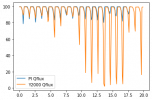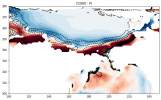-
The www2.cesm.ucar.edu website is currently down for maintenance
You are using an out of date browser. It may not display this or other websites correctly.
You should upgrade or use an alternative browser.
You should upgrade or use an alternative browser.
FAQ: Data ocean slab mode (DOCN-SOM)
- Thread starter dbailey
- Start date
Hello Dave,
I'm attempting to generate a SOM Q-flux file using CESM1-POP2 data from a Year 2000 simulation (last 100 years of a 500 year equilibrium simulation at this time). The climate in this simulation appears to be mostly equilibrated, so I thought it would be suitable for generating a SOM Q-flux. I started a timeslice run using Q-flux generated from this simulation using the pop_frc_mlt.ncl script. However, I found that about ~10 years into the simulation, the Y2000 Qflux case has a dramatic loss of summertime sea ice in the central Arctic (first attached figure for aice at ~81N,220E), rendering the Arctic ice free in summer. The sea ice cover is larger in the original Y2000 coupled simulation, so it seems like there is something wrong with the Qflux I've generated.
Do you have any advice on how to deal with this issue? Something I notice when comparing the September Y2000 to PI Qflux is that there is a small negative anomaly that extends into the Central Arctic (second attached figure). If I understand correctly, this means that there is an anomalous input of heat into the slab ocean layer. Could this be large enough to melt the ice entirely as I'm seeing?
Thanks,
Haruki
I'm attempting to generate a SOM Q-flux file using CESM1-POP2 data from a Year 2000 simulation (last 100 years of a 500 year equilibrium simulation at this time). The climate in this simulation appears to be mostly equilibrated, so I thought it would be suitable for generating a SOM Q-flux. I started a timeslice run using Q-flux generated from this simulation using the pop_frc_mlt.ncl script. However, I found that about ~10 years into the simulation, the Y2000 Qflux case has a dramatic loss of summertime sea ice in the central Arctic (first attached figure for aice at ~81N,220E), rendering the Arctic ice free in summer. The sea ice cover is larger in the original Y2000 coupled simulation, so it seems like there is something wrong with the Qflux I've generated.
Do you have any advice on how to deal with this issue? Something I notice when comparing the September Y2000 to PI Qflux is that there is a small negative anomaly that extends into the Central Arctic (second attached figure). If I understand correctly, this means that there is an anomalous input of heat into the slab ocean layer. Could this be large enough to melt the ice entirely as I'm seeing?
Thanks,
Haruki
Attachments
I would expect that a year 2000 SOM forcing file would be very warm from a climate state that is not in balance. That is why we tend to stick with 1850 picontrol runs as these are better equilibrated with a top of atmosphere of near zero. There is a Meehl et al. paper that talks about the issues of a 2000 control run.
mpb20@st-andrews_ac_uk
New Member
Hi there,
I've recently been running cesm2.1.3 at resolution f19_g16 with the following compset: 1850_CAM40_CLM40%CN_CICE_DOCN%SOM_RTM_SGLC_SWAV
The slab-ocean forcing file is: pop_frc.b.c40.B1850CN.f19_g16.100105.nc
What I find is that the model becomes progressively colder and colder before crashing after approximately 35 years. This behaviour is surprising, and I'm wondering whether anyone else has seen this using cesm2 and a similar compset?
Cheers,
Mike
I've recently been running cesm2.1.3 at resolution f19_g16 with the following compset: 1850_CAM40_CLM40%CN_CICE_DOCN%SOM_RTM_SGLC_SWAV
The slab-ocean forcing file is: pop_frc.b.c40.B1850CN.f19_g16.100105.nc
What I find is that the model becomes progressively colder and colder before crashing after approximately 35 years. This behaviour is surprising, and I'm wondering whether anyone else has seen this using cesm2 and a similar compset?
Cheers,
Mike
Hi Dave,
I would like to create an instantaneous 2xCO2 run that branches from a piControl slab ocean simulation (compset E1850C5CN). I'm running cesm 1.1.2 and the piControl uses the SOM forcing derived from the fully coupled piControl available online.
After reading the user guide, I think all I need to do is change the variable 'co2vmr' from 284.7e-6 to 569.4e-6 since the 'scenario_ghg' variable is set to 'fixed'. Is this correct ? Are there other steps that need to be taken ?
Thanks,
Etienne
I would like to create an instantaneous 2xCO2 run that branches from a piControl slab ocean simulation (compset E1850C5CN). I'm running cesm 1.1.2 and the piControl uses the SOM forcing derived from the fully coupled piControl available online.
After reading the user guide, I think all I need to do is change the variable 'co2vmr' from 284.7e-6 to 569.4e-6 since the 'scenario_ghg' variable is set to 'fixed'. Is this correct ? Are there other steps that need to be taken ?
Thanks,
Etienne
tienyiah@uci_edu
New Member
This might be useful to users who need to know the exact definition of SHF. I figure out that the formula of SHF is
SHF = SHF_QSW + LWDN_F + LWUP_F + SENH_F + EVAP_F * latent_heat_vapor + MELTH_F - (SNOW_F + IOFF_F) * latent_heat_fusion * 1e-4
SHF > 0 means energy flux pointing downward (ocean receives energy)
This is validated in the output file of POP2 used in CESM1.2.2.1.
SHF = SHF_QSW + LWDN_F + LWUP_F + SENH_F + EVAP_F * latent_heat_vapor + MELTH_F - (SNOW_F + IOFF_F) * latent_heat_fusion * 1e-4
SHF > 0 means energy flux pointing downward (ocean receives energy)
This is validated in the output file of POP2 used in CESM1.2.2.1.
tienyiah@uci_edu
New Member
Quick verification code using ncap2 of nco
> ncap2 -v -s "check_residue=SHF-(SHF_QSW + LWDN_F + LWUP_F + SENH_F + EVAP_F * latent_heat_vapor + MELTH_F - (SNOW_F + IOFF_F) * latent_heat_fusion * 1e-4)" <input_file> <output_file>
My computed residue is about 0.001 W/m^2
> ncap2 -v -s "check_residue=SHF-(SHF_QSW + LWDN_F + LWUP_F + SENH_F + EVAP_F * latent_heat_vapor + MELTH_F - (SNOW_F + IOFF_F) * latent_heat_fusion * 1e-4)" <input_file> <output_file>
My computed residue is about 0.001 W/m^2
Hi, grad student here-- I have a question about the surface heat fluxes in the SOM vs. FCM. The FCM has an outputted variable called SHF on the ocean grid (which seems to be calculated via equation tienyiah@uci_edu suggested above). I calculated the Fnet manually on the atmospheric grid for the FCM using equation Fnet = FSNS - FLNS - LHFLX - SHFLX, interpolated SHF to atmospheric grid and compared them.
SHF and Fnet both for the FCM surprised me, as they have pretty low correlations in the subtropics and tropics globally. I am wondering why SHF and Fnet for the FCM don't match-- what exactly is included in the model SHF calculation that is not physically included in the Fnet?
Thanks for any insights,
Olivia
SHF and Fnet both for the FCM surprised me, as they have pretty low correlations in the subtropics and tropics globally. I am wondering why SHF and Fnet for the FCM don't match-- what exactly is included in the model SHF calculation that is not physically included in the Fnet?
Thanks for any insights,
Olivia
I assume by FCM you mean fully coupled model? The SOM forcing comes from a PI control (1850) control run. The SOM simulation as described in the FAQ at the top of this, just solved d(SST)/dt = (Fnet - Qflux) / (rho*cp*hmix). These are a climatological year which likely does not correspond to the period of your fully-coupled run.
Hi, quick question. Say I wish to simply turn off ocean heat transport, could I just set hblt to a constant and all other variables to zero in the slab ocean forcing file? Also, I am wondering is the mask variable in this file actually used? I am doing some deep time simulations and I am wondering if I actually need to look into how to modify the REGION_MASK if I just want to run slab ocean and not fully coupled.
Also, a slightly off-topic question, do I need to have land over the poles if I am using slab ocean, or is this only a requirement for POP?
Also, a slightly off-topic question, do I need to have land over the poles if I am using slab ocean, or is this only a requirement for POP?
Would you mind giving a bit of further guidance on how to do that? It seems the smallest possible intervention is to keep reading the default SOM file in, but ignore its mixed layer depth and heat fluxes, and overwrite them my own. Is this okay even though I am no longer on the standard G grid (I moved the poles). Furthermore, my mask is very different?
My idea is to set hn to a constant depth and delete the contribution of kqbot to the heat budget. However, my deep-time land-sea mask is very different. Would it cause problems if I just ignore the "if (imask(n) /= 0) then" conditional and integrate all grid cell SSTs prognostically even if they are actually land? Thank you so much for your help!
My idea is to set hn to a constant depth and delete the contribution of kqbot to the heat budget. However, my deep-time land-sea mask is very different. Would it cause problems if I just ignore the "if (imask(n) /= 0) then" conditional and integrate all grid cell SSTs prognostically even if they are actually land? Thank you so much for your help!
Hey,
I'm looking for a SOM simulations include the atmosphere and land coupled to a slab ocean. The compset QSC6 is found to be a Aquaplanet one which land is not active.
Was it necessary for me to create a user-defined compset for this?
Is it possible to use an unsupported compset for research (did I need to verify or validate the result)?
I noticed that the compset beginning with E is the ETEST and the E1850TEST, which are intended for software testing according to the instructions. Can I use the same for the scientific approach?
Thanks in advance
Sreerag
I'm looking for a SOM simulations include the atmosphere and land coupled to a slab ocean. The compset QSC6 is found to be a Aquaplanet one which land is not active.
Was it necessary for me to create a user-defined compset for this?
Is it possible to use an unsupported compset for research (did I need to verify or validate the result)?
I noticed that the compset beginning with E is the ETEST and the E1850TEST, which are intended for software testing according to the instructions. Can I use the same for the scientific approach?
Thanks in advance
Sreerag
yefee90@gmail_com
New Member
Hi Dave, I hope you are doing well! Thanks for this wonderful thread, and I learned a lot from it.
One native question here: I found the hblt in the forcing file is the annual mean, would it be possible to replace it with monthly climatology? Would the model linearly interpolate the hblt along the time-axis as the qflx?
I suppose I have to modify the thermal equation a little bit in the docn module, as rho Cp d(HT)/dt = Qsfc - Qflx --> rho Cp H_bar dT/dt = Qsfc - Qflx - rho Cp T_bar dH/dt...
One native question here: I found the hblt in the forcing file is the annual mean, would it be possible to replace it with monthly climatology? Would the model linearly interpolate the hblt along the time-axis as the qflx?
I suppose I have to modify the thermal equation a little bit in the docn module, as rho Cp d(HT)/dt = Qsfc - Qflx --> rho Cp H_bar dT/dt = Qsfc - Qflx - rho Cp T_bar dH/dt...


